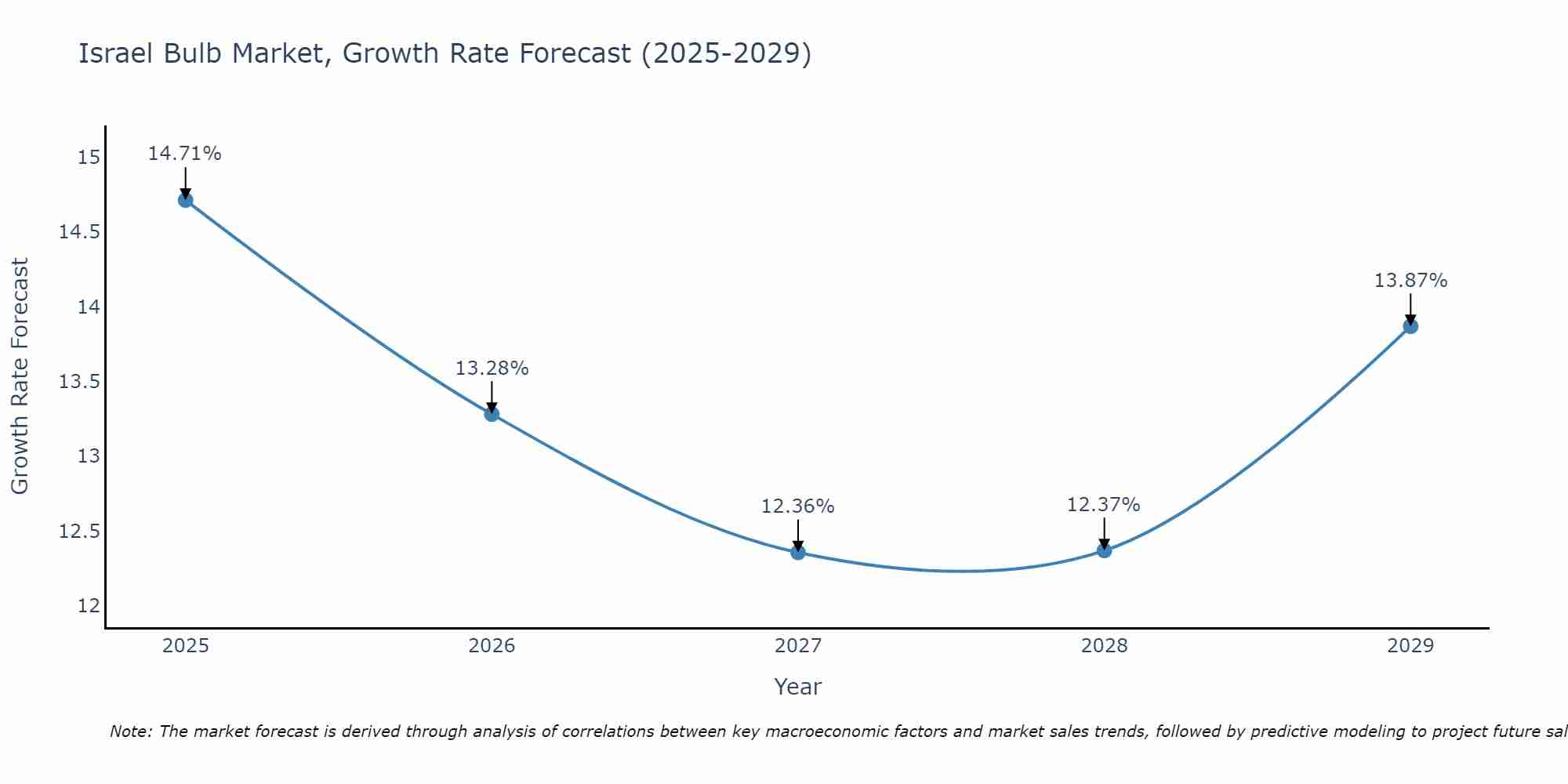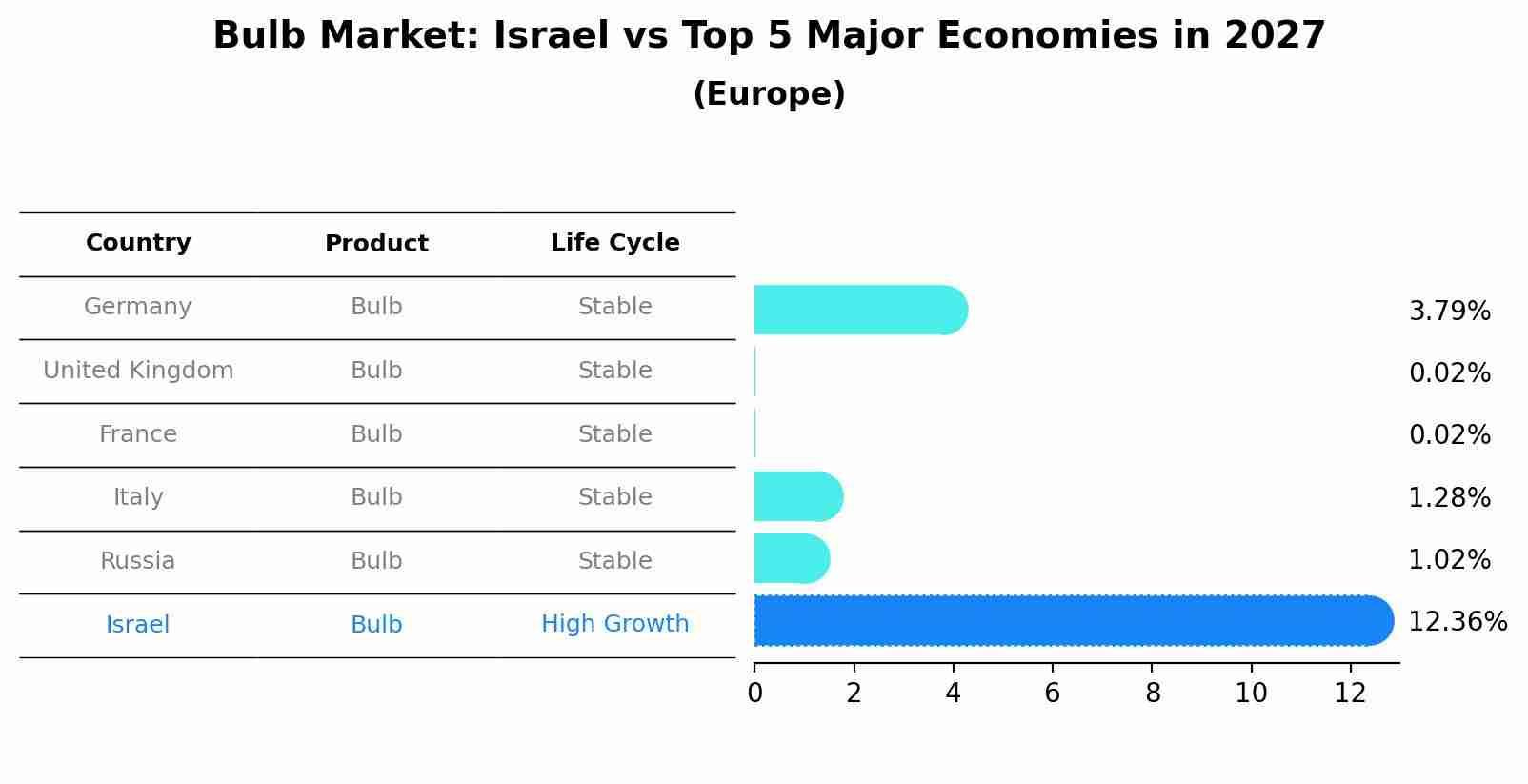Israel Bulb Market (2025-2031) | Industry, Analysis, Size, Forecast, Growth, Outlook, Share, Trends, Segmentation, Companies, Value & Revenue
| Product Code: ETC5110839 | Publication Date: Nov 2023 | Updated Date: Apr 2025 | Product Type: Market Research Report | |
| Publisher: 6Wresearch | No. of Pages: 60 | No. of Figures: 30 | No. of Tables: 5 | |
Israel Bulb Market Size Growth Rate
The Israel Bulb Market is projected to witness mixed growth rate patterns during 2025 to 2029. Starting high at 14.71% in 2025, the market steadily declines to 13.87% by 2029.

Bulb Market: Israel vs Top 5 Major Economies in 2027 (Europe)
Israel's Bulb market is anticipated to experience a high growth rate of 12.36% by 2027, reflecting trends observed in the largest economy Germany, followed by United Kingdom, France, Italy and Russia.

Israel Bulb Market Synopsis
The bulb market in Israel encompasses a wide range of lighting solutions including incandescent, fluorescent, LED (Light Emitting Diode), and halogen bulbs. With the increasing emphasis on energy efficiency and environmental sustainability, there has been a significant shift towards LED lighting technology in recent years. LED bulbs offer numerous benefits such as lower energy consumption, longer lifespan, and reduced maintenance costs compared to traditional lighting options. As a result, the demand for LED bulbs is steadily increasing across residential, commercial, and industrial sectors in Israel. Furthermore, government regulations phasing out inefficient lighting technologies and promoting the adoption of LEDs are driving market growth.
Drivers of the market
The bulb market in Israel is evolving with the transition towards energy-efficient lighting technologies such as LED bulbs. Government regulations phasing out inefficient incandescent bulbs and promoting energy-saving alternatives have accelerated this shift. Additionally, increasing consumer awareness of environmental sustainability and the long-term cost benefits of LED lighting drive the market towards more efficient and eco-friendly lighting solutions.
Challenges of the market
The Israel Bulb market confronts several challenges amid the transition to more energy-efficient lighting solutions. One significant obstacle is the gradual phasing out of traditional incandescent bulbs in favor of LED and CFL bulbs, driven by energy efficiency regulations and consumer preferences. This transition poses challenges for manufacturers and retailers still reliant on traditional bulb sales. Additionally, the influx of low-cost LED bulbs from international markets puts pressure on domestic manufacturers to compete on price and quality. Moreover, ensuring proper disposal and recycling of older, less efficient bulbs presents environmental challenges. To thrive in this evolving market, companies need to adapt their product offerings, invest in LED technology, and explore opportunities for recycling and sustainability initiatives.
Government Policy of the market
In the bulb market, government policies target energy conservation and environmental protection. Regulations phase out the use of inefficient incandescent bulbs in favor of energy-saving alternatives such as LED and CFL bulbs. The government also implements labeling schemes to inform consumers about the energy efficiency of different bulb models and promotes public awareness campaigns to encourage the adoption of energy-efficient lighting technologies.
Key Highlights of the Report:
- Israel Bulb Market Outlook
- Market Size of Israel Bulb Market, 2024
- Forecast of Israel Bulb Market, 2031
- Historical Data and Forecast of Israel Bulb Revenues & Volume for the Period 2021-2031
- Israel Bulb Market Trend Evolution
- Israel Bulb Market Drivers and Challenges
- Israel Bulb Price Trends
- Israel Bulb Porter`s Five Forces
- Israel Bulb Industry Life Cycle
- Historical Data and Forecast of Israel Bulb Market Revenues & Volume By Type for the Period 2021-2031
- Historical Data and Forecast of Israel Bulb Market Revenues & Volume By Incandescent Bulbs for the Period 2021-2031
- Historical Data and Forecast of Israel Bulb Market Revenues & Volume By Fluorescent Bulbs for the Period 2021-2031
- Historical Data and Forecast of Israel Bulb Market Revenues & Volume By CFLs for the Period 2021-2031
- Historical Data and Forecast of Israel Bulb Market Revenues & Volume By Halogens for the Period 2021-2031
- Historical Data and Forecast of Israel Bulb Market Revenues & Volume By LEDs for the Period 2021-2031
- Historical Data and Forecast of Israel Bulb Market Revenues & Volume By Application for the Period 2021-2031
- Historical Data and Forecast of Israel Bulb Market Revenues & Volume By Lamps & Light Bulbs for the Period 2021-2031
- Historical Data and Forecast of Israel Bulb Market Revenues & Volume By Operation Theatre (OT Instruments) for the Period 2021-2031
- Historical Data and Forecast of Israel Bulb Market Revenues & Volume By Torchlights and Flashlights for the Period 2021-2031
- Historical Data and Forecast of Israel Bulb Market Revenues & Volume By Automobile Headlights for the Period 2021-2031
- Historical Data and Forecast of Israel Bulb Market Revenues & Volume By Mining Headgears for the Period 2021-2031
- Historical Data and Forecast of Israel Bulb Market Revenues & Volume By Others for the Period 2021-2031
- Israel Bulb Import Export Trade Statistics
- Market Opportunity Assessment By Type
- Market Opportunity Assessment By Application
- Israel Bulb Top Companies Market Share
- Israel Bulb Competitive Benchmarking By Technical and Operational Parameters
- Israel Bulb Company Profiles
- Israel Bulb Key Strategic Recommendations
Frequently Asked Questions About the Market Study (FAQs):
1 Executive Summary |
2 Introduction |
2.1 Key Highlights of the Report |
2.2 Report Description |
2.3 Market Scope & Segmentation |
2.4 Research Methodology |
2.5 Assumptions |
3 Israel Bulb Market Overview |
3.1 Israel Country Macro Economic Indicators |
3.2 Israel Bulb Market Revenues & Volume, 2021 & 2031F |
3.3 Israel Bulb Market - Industry Life Cycle |
3.4 Israel Bulb Market - Porter's Five Forces |
3.5 Israel Bulb Market Revenues & Volume Share, By Type, 2021 & 2031F |
3.6 Israel Bulb Market Revenues & Volume Share, By Application, 2021 & 2031F |
4 Israel Bulb Market Dynamics |
4.1 Impact Analysis |
4.2 Market Drivers |
4.3 Market Restraints |
5 Israel Bulb Market Trends |
6 Israel Bulb Market Segmentations |
6.1 Israel Bulb Market, By Type |
6.1.1 Overview and Analysis |
6.1.2 Israel Bulb Market Revenues & Volume, By Incandescent Bulbs, 2021-2031F |
6.1.3 Israel Bulb Market Revenues & Volume, By Fluorescent Bulbs, 2021-2031F |
6.1.4 Israel Bulb Market Revenues & Volume, By CFLs, 2021-2031F |
6.1.5 Israel Bulb Market Revenues & Volume, By Halogens, 2021-2031F |
6.1.6 Israel Bulb Market Revenues & Volume, By LEDs, 2021-2031F |
6.2 Israel Bulb Market, By Application |
6.2.1 Overview and Analysis |
6.2.2 Israel Bulb Market Revenues & Volume, By Lamps & Light Bulbs, 2021-2031F |
6.2.3 Israel Bulb Market Revenues & Volume, By Operation Theatre (OT Instruments), 2021-2031F |
6.2.4 Israel Bulb Market Revenues & Volume, By Torchlights and Flashlights, 2021-2031F |
6.2.5 Israel Bulb Market Revenues & Volume, By Automobile Headlights, 2021-2031F |
6.2.6 Israel Bulb Market Revenues & Volume, By Mining Headgears, 2021-2031F |
6.2.7 Israel Bulb Market Revenues & Volume, By Others, 2021-2031F |
7 Israel Bulb Market Import-Export Trade Statistics |
7.1 Israel Bulb Market Export to Major Countries |
7.2 Israel Bulb Market Imports from Major Countries |
8 Israel Bulb Market Key Performance Indicators |
9 Israel Bulb Market - Opportunity Assessment |
9.1 Israel Bulb Market Opportunity Assessment, By Type, 2021 & 2031F |
9.2 Israel Bulb Market Opportunity Assessment, By Application, 2021 & 2031F |
10 Israel Bulb Market - Competitive Landscape |
10.1 Israel Bulb Market Revenue Share, By Companies, 2024 |
10.2 Israel Bulb Market Competitive Benchmarking, By Operating and Technical Parameters |
11 Company Profiles |
12 Recommendations | 13 Disclaimer |
- Single User License$ 1,995
- Department License$ 2,400
- Site License$ 3,120
- Global License$ 3,795
Search
Related Reports
- Portugal Electronic Document Management Market (2025-2031) | Strategy, Consumer Insights, Analysis, Investment Trends, Opportunities, Growth, Size, Share, Industry, Revenue, Segments, Value, Segmentation, Supply, Forecast, Restraints, Outlook, Competition, Drivers, Trends, Demand, Pricing Analysis, Competitive, Strategic Insights, Companies, Challenges
- France Electronic Document Management Market (2025-2031) | Strategy, Consumer Insights, Analysis, Investment Trends, Opportunities, Growth, Size, Share, Industry, Revenue, Segments, Value, Segmentation, Supply, Forecast, Restraints, Outlook, Competition, Drivers, Trends, Demand, Pricing Analysis, Competitive, Strategic Insights, Companies, Challenges
- Portugal Occupational Health & Safety Services Market (2025-2031) | Strategy, Consumer Insights, Analysis, Investment Trends, Opportunities, Growth, Size, Share, Industry, Revenue, Segments, Value, Segmentation, Supply, Forecast, Restraints, Outlook, Competition, Drivers, Trends, Demand, Pricing Analysis, Competitive, Strategic Insights, Companies, Challenges
- Netherlands Occupational Health and Safety Services Market (2025-2031) | Strategy, Consumer Insights, Analysis, Investment Trends, Opportunities, Growth, Size, Share, Industry, Revenue, Segments, Value, Segmentation, Supply, Forecast, Restraints, Outlook, Competition, Drivers, Trends, Demand, Pricing Analysis, Competitive, Strategic Insights, Companies, Challenges
- Belgium and Luxembourg Facility Management Market (2025-2031) | Strategy, Consumer Insights, Analysis, Investment Trends, Opportunities, Growth, Size, Share, Industry, Revenue, Segments, Value, Segmentation, Supply, Forecast, Restraints, Outlook, Competition, Drivers, Trends, Demand, Pricing Analysis, Competitive, Strategic Insights, Companies, Challenges
- Russia Women Intimate Apparel Market (2025-2031) | Strategy, Consumer Insights, Analysis, Investment Trends, Opportunities, Growth, Size, Share, Industry, Revenue, Segments, Value, Segmentation, Supply, Forecast, Restraints, Outlook, Competition, Drivers, Trends, Demand, Pricing Analysis, Competitive, Strategic Insights, Companies, Challenges
- Africa Chocolate Market (2025-2031) | Size, Share, Trends, Growth, Revenue, Analysis, Forecast, industry & Outlook
- Global Hydroxychloroquine And Chloroquine Market (2025-2031) | Industry, Trends, Size, Outlook, Growth, Value, Companies, Revenue, Analysis, Share, Forecast
- Saudi Arabia Plant Maintenance Market (2025-2031) | Industry, Size, Growth, Revenue, Value, Companies, Forecast, Analysis, Share & Trends
- Taiwan Electric Truck Market (2025-2031) | Outlook, Industry, Revenue, Size, Forecast, Growth, Analysis, Share, Companies, Value & Trends
Industry Events and Analyst Meet
Our Clients
Whitepaper
- Middle East & Africa Commercial Security Market Click here to view more.
- Middle East & Africa Fire Safety Systems & Equipment Market Click here to view more.
- GCC Drone Market Click here to view more.
- Middle East Lighting Fixture Market Click here to view more.
- GCC Physical & Perimeter Security Market Click here to view more.
6WResearch In News
- Doha a strategic location for EV manufacturing hub: IPA Qatar
- Demand for luxury TVs surging in the GCC, says Samsung
- Empowering Growth: The Thriving Journey of Bangladesh’s Cable Industry
- Demand for luxury TVs surging in the GCC, says Samsung
- Video call with a traditional healer? Once unthinkable, it’s now common in South Africa
- Intelligent Buildings To Smooth GCC’s Path To Net Zero













